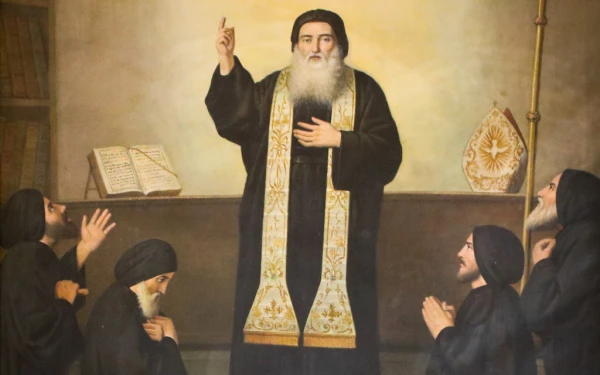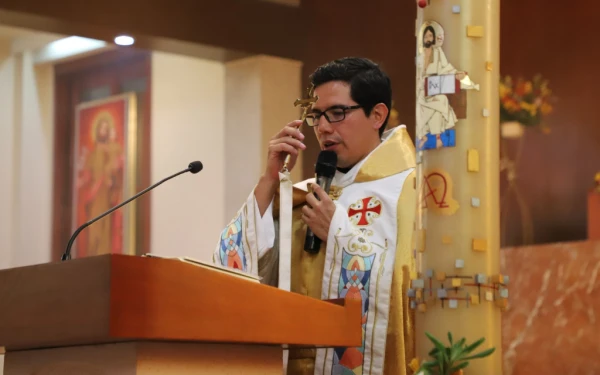Devotion to the first eastern saint, Saint Charbel Makhlouf, has crossed borders from Lebanon to America, where he is venerated with great fervor. This religious phenomenon is closely linked to the Maronite rite, a Catholic tradition with deep roots in the history of Eastern Christianity.
Unlike other Eastern Christian groups, “they have always been Catholic, they never separated from Rome,” according to the maronites.org website, where their history and beliefs are explained.
Receive the main news from ACI Prensa by WhatsApp and Telegram
It is increasingly difficult to see Catholic news on social media. Subscribe to our free channels today:
The Universal Catholic Church, in its diversity, is made up of 24 Ritual Churches: the Latin Church in the West and the remaining 23 Churches in the East, all in communion with the Pope. Although they share the same dogmas and doctrines, each of these Churches enjoys a certain autonomy in some matters, including their liturgical rites and traditions.
The Maronite rite is one of the best known among the Eastern rites. The Maronite website notes that this Church is named after Maron, a hermit from northern Syria, who founded a spiritual and monastic movement. Maron, who lived in the second half of the 4th century, established the School of Cenobitism, attracting a group of followers eager to live under his spiritual guidance. After his death, these followers organized themselves as a community of faithful who took the name of Maronites.

The Maronite Church was consolidated as a Christian community in the mountains of present-day Lebanon, a place that is considered its spiritual cradle and identity. However, the website indicates that the Maronite Church is not a national church; therefore, “not all Lebanese are Maronites, nor are all Maronites Lebanese.”
Main differences with the Latin rite Catholic Church
The Maronite rite, like other Eastern rites, presents several differences with the Latin rite, which is the most widespread within the Catholic Church and whose main representative is the Roman rite. These differences include liturgical, hierarchical and disciplinary aspects.
Father Jonathan Ángeles Valencia, parish priest of Our Lady of Lebanon in Puebla and spokesman for the Maronite Diocese of Mexico, explains that, although in the hierarchical structure the Pope is the head of the Church in both rites, in the Maronite rite immediately after Next to the Pope is the Maronite Patriarch, who leads this specific rite.
The priest mentioned that this Patriarch is below the Holy Father and acts as the visible head of the Maronite rite, both in Lebanon and among the Maronites in the diaspora. On the other hand, in the Latin rite, there is no figure equivalent to the Patriarch in terms of specific liturgical leadership.
Another difference that Father Ángeles Valencia highlights is that the Maronite liturgy is based on an Antiochene-Syriac tradition, a legacy of ancient Christian sees such as Antioch and Alexandria.
“It changes the question of the celebration of the Eucharist, in the prayers, in the language, the liturgical language is Syriac and therefore also the vestments,” explains the priest.
He also points out that the priests use “ornaments that are very different from Latin ornaments; “One of the particularities is the cross in the hand that the priest carries in the celebration.”

Father Ángeles Valencia also highlights that “another difference is that married clergy exist.” According to the website, “once receiving the sacrament of marriage, the man could access the priesthood.” This practice regularly requires the permission of the Pope.
Another element in which it changes is the language used in the Masses. According to the Maronite website, their liturgical language is Aramaic, “the very mother tongue of Jesus Christ,” although the entire Mass is celebrated in the language of the region where it is celebrated. However, the essential prayers of the Mass and the liturgy remain in Aramaic.
Finally, in the Maronite rite it is traditional to administer Confirmation together with the Sacrament of Baptism, a common practice in many Eastern Churches. In contrast, in the Latin rite, these sacraments are usually administered separately and at different times in the lives of the faithful.
The Maronite website indicates that the presence of this rite shows the “spiritual richness” of the universal Catholic Church, in addition to its “greatness and respect, and its freedom to venerate the different rites at the heart of its unity.”

